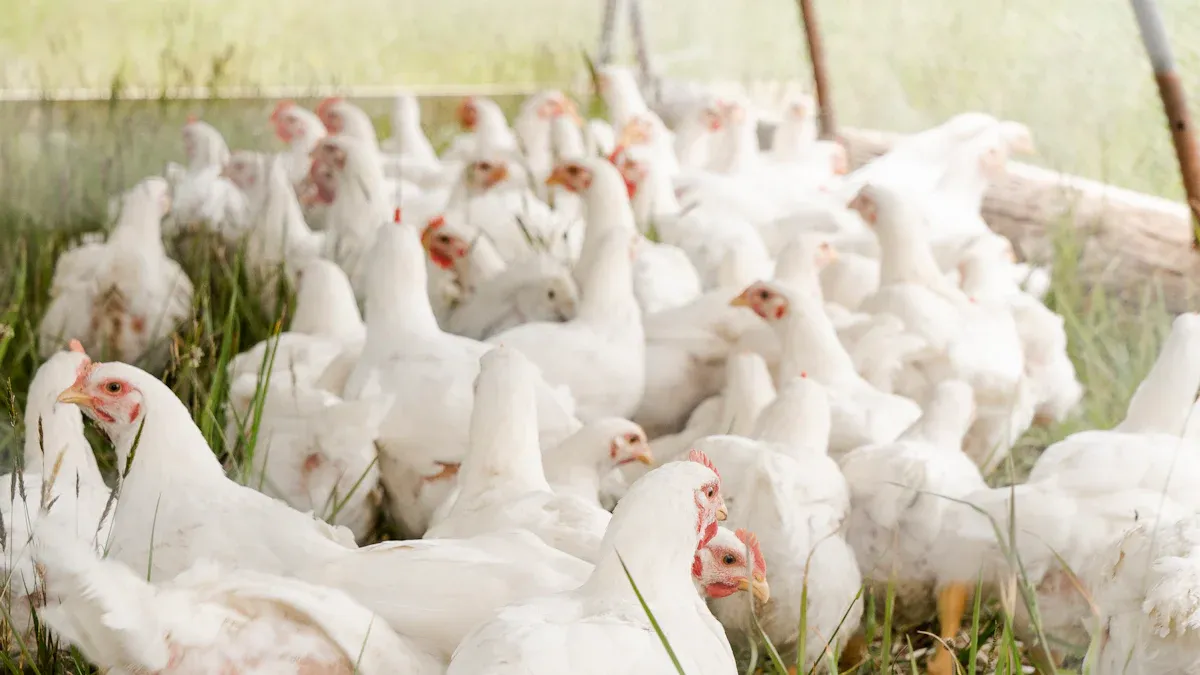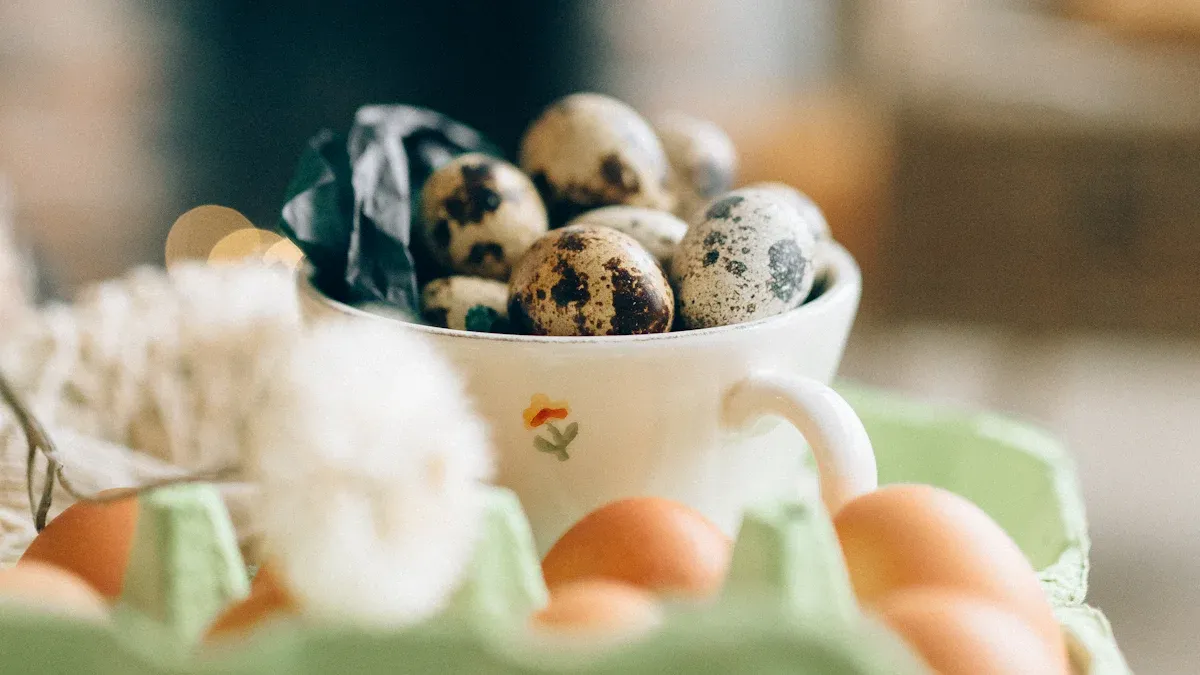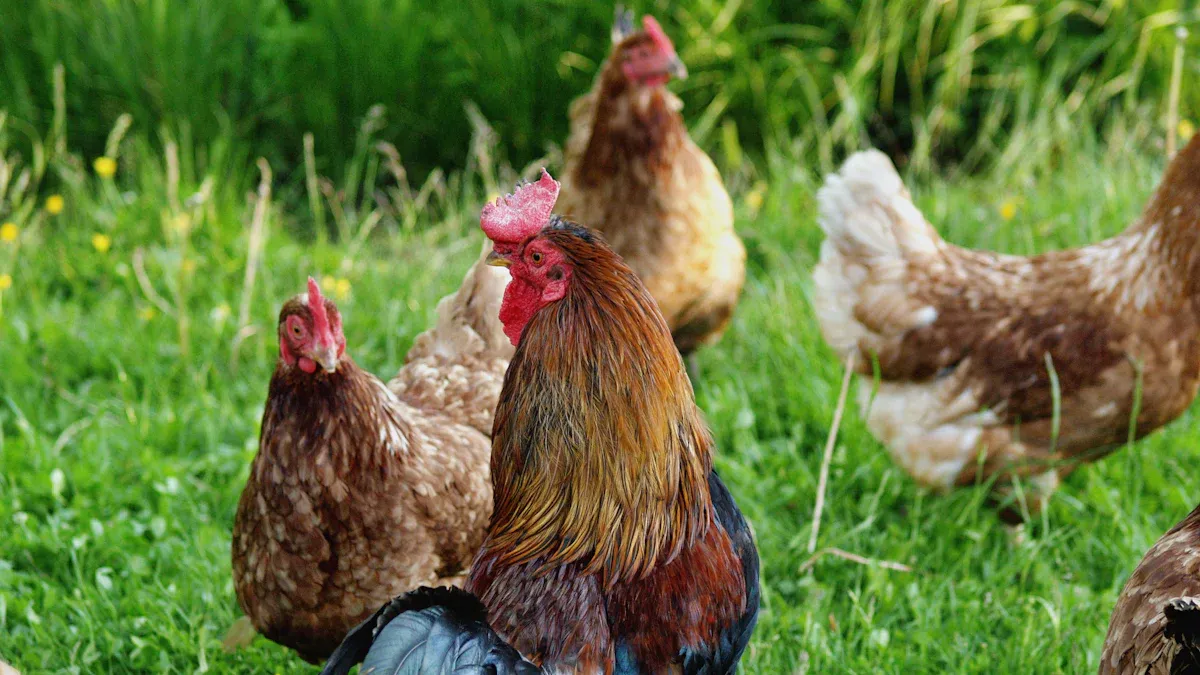
Dried mealworms for poultry are a game-changer when it comes to boosting health and growth. Packed with high protein and essential nutrients, they help chickens grow faster and stay healthier. Studies show that replacing soybean meal with mealworms at a 15% level improves broiler growth and carcass quality. Plus, hens fed mealworms lay better-quality eggs and produce more of them. For South American farmers, mealworms offer a practical solution to feed shortages and rising costs, ensuring stronger, more productive flocks.
Key Takeaways
- Dried mealworms are a protein-rich food that helps poultry grow. They can take the place of feeds like soybean meal. This leads to faster growth and better meat quality.
- Adding mealworms to poultry diets makes eggs better and more plentiful. Hens eating mealworms lay more eggs with stronger shells and brighter yolks.
- Using dried mealworms helps farmers in South America with feed problems. This eco-friendly option lowers the need for imported feeds and aids local farms.
Nutritional Benefits of Dried Mealworms for Poultry

High Protein Content for Growth
Protein is essential for poultry growth, and dried mealworms for poultry are a powerhouse of this nutrient. Compared to traditional feed sources like soybean meal, mealworms offer significantly higher protein levels. Take a look at this comparison:
| Nutritional Item | Mealworm Meal (per 100 g) | Soybean Meal (per 100 g) |
|---|---|---|
| Crude Protein | 59.2 g | 44 g |
| Crude Fat | 24 g | 0.5 g |
| Crude Fiber | 9.3 g | 7.0 g |
Mealworms also contain healthy fats and amino acids, which are vital for body repair and feather development. Studies show that adding mealworms to poultry diets improves nutrient absorption and reduces overall feed consumption. This makes them an efficient and cost-effective choice for farmers.
Essential Nutrients for Immunity and Health
Dried mealworms are more than just a protein source. They act as an immune booster, helping chickens fend off diseases naturally. Packed with essential nutrients, they promote overall vitality and reduce the need for medications.
- Mealworms provide healthy fats and amino acids, which enhance energy levels and support active lifestyles.
- They encourage natural foraging behavior, keeping chickens mentally stimulated and physically active.
- As a natural, unprocessed treat, mealworms contribute to a healthier flock without the risks associated with artificial additives.
Improved Egg Quality and Production
For laying hens, dried mealworms for poultry are a game-changer. Their high protein content supports consistent egg production and improves egg quality. Farmers often notice thicker shells and richer yolk colors when mealworms are part of the diet.
- Mealworms provide vital nutrients needed for efficient egg-laying.
- Hens fed mealworms lay eggs more frequently and with better consistency.
- The nutritional density of mealworms enhances the overall health of laying hens, leading to better-quality eggs.
By incorporating dried mealworms into poultry diets, farmers can ensure healthier flocks, better growth, and improved egg production.
Benefits for South American Poultry Farmers
Addressing Feed Shortages and Costs
Feed shortages and rising costs are common challenges for South American poultry farmers. Dried mealworms for poultry offer a practical solution. These nutrient-rich insects can replace traditional feed ingredients like soybean meal, which are often expensive and less sustainable. Farmers can reduce their reliance on imported feed, cutting costs and ensuring a steady supply of high-quality nutrition for their flocks.
Mealworms are also highly efficient. Their dense protein content means chickens need less feed to meet their nutritional needs. This efficiency helps farmers save money while maintaining healthy, productive birds. By incorporating mealworms into their feeding strategies, farmers can tackle feed shortages and improve their bottom line.
Adapting to Climate and Environmental Challenges
South America’s diverse climates can make poultry farming unpredictable. Dried mealworms provide a sustainable and adaptable feed option that thrives in various environments. Studies highlight their environmental benefits, such as lower greenhouse gas emissions compared to traditional feed sources.
| Study Title | Findings | Environmental Impact |
|---|---|---|
| The acceptability of yellow mealworm as chicken feed | Improved sustainability of poultry diets | Lower greenhouse gas emissions compared to traditional feed |
| Nutritional Benefits of Bulk Dried Mealworms as Feed | Sustainable choice for poultry diets | Reduced environmental burden compared to traditional livestock farming |
Farmers can rely on mealworms to support their flocks, even in challenging conditions. Their production requires fewer resources, making them an eco-friendly choice for regions facing environmental stress.
Supporting Local Poultry Breeds
Local poultry breeds often require specialized care and nutrition. Dried mealworms for poultry can meet these unique needs. Case studies show that adding mealworms to diets improves growth performance and overall health in small-scale farming systems.
| Study Title | Findings |
|---|---|
| The acceptability of yellow mealworm as chicken feed: a case study of small-scale farmers in South Africa | Demonstrated improvements in growth performance and overall health of poultry when dried mealworms were included in their diet. |
| Evaluation of yellow mealworm meal as a protein feedstuff in the diet of broiler chicks | Highlighted positive effects on carcass characteristics and growth performance in broiler chicks fed with yellow mealworm meal. |
Farmers raising native breeds can use mealworms to enhance productivity without compromising the birds’ natural traits. This approach supports biodiversity and strengthens local farming practices.
Practical Use of Dried Mealworms for Poultry

How to Add Mealworms to Poultry Diets
Adding dried mealworms to poultry diets is simple and effective. Farmers can mix them directly into regular feed or scatter them on the ground to encourage natural foraging. This method not only provides nutrition but also keeps chickens active and engaged. Research shows that dried mealworm meal can replace traditional feedstuffs like soybean meal due to its high nutritional value. Packed with proteins, polyunsaturated fatty acids, dietary fibers, and essential micronutrients, mealworms are a versatile addition to any poultry diet.
Feeding Quantities for Optimal Growth
The right amount of dried mealworms ensures optimal growth and health. For adult chickens, a handful of mealworms per day is usually sufficient. For younger birds, smaller portions work best to avoid overfeeding. Farmers should aim for balance by combining mealworms with other feed components. This approach ensures chickens receive all the nutrients they need without excess. Monitoring the flock’s health and egg production can help fine-tune feeding quantities over time.
Tips for Maximizing Benefits
To get the most out of dried mealworms for poultry, consider these tips:
- Use mealworms as a protein-rich supplement alongside regular feed.
- Scatter mealworms to promote natural foraging behavior, which boosts mental and physical health.
- Incorporate mealworms into the diet to improve egg quality, including richer yolk color and size.
- Adjust feeding quantities based on the flock’s age, size, and production goals.
By following these practices, farmers can ensure their poultry thrives while enjoying the many benefits of this nutrient-packed feed option.
Economic and Environmental Advantages
Cost-Effective and Sustainable Feed Option
Dried mealworms offer a cost-effective solution for poultry farmers looking to optimize their feed expenses. Studies show that mealworms can replace traditional protein sources like soybean meal, which are often expensive and less sustainable. Their high nutritional value, including proteins and essential fatty acids, ensures that farmers get more value per unit of feed.
| Metric | Result |
|---|---|
| Protein Cost | Decreased |
| Total Revenue | Increased |
| Profit Margins | Increased |
| Total Feed Cost | Increased due to high MWM cost |
| Cost-Benefit Ratio (CBR) | Decreased after MWM replacement |
| Return on Investment (RoI) | Decreased after MWM replacement |
| Market Growth Rate | Expected to grow at 28.6% from 2022–2030 |
Mealworms also require fewer resources to produce compared to traditional feed ingredients. Their efficient conversion of organic matter into protein reduces production costs and environmental impact, making them a sustainable choice for modern poultry farming.
Reducing Dependence on Traditional Feeds
Farmers can reduce their reliance on conventional feed ingredients by incorporating mealworms into poultry diets. This shift is especially beneficial for small-scale farmers who face challenges with the rising costs of soybean and fishmeal.
- Mealworms provide a high-energy, nutrient-dense alternative to traditional feeds.
- Their inclusion in broiler diets improves protein and fat digestibility, reducing the overall amount of feed required.
- Farmers in South Africa have shown a willingness to adopt mealworms, highlighting their potential to replace conventional protein sources.
By diversifying feed options, farmers can ensure a steady supply of nutrition for their flocks while lowering dependency on imported feed ingredients.
Promoting Eco-Friendly Poultry Farming
Mealworms contribute to eco-friendly farming practices by reducing the environmental footprint of poultry production. They require less space, water, and energy to produce compared to traditional livestock feed.
- Mealworms convert organic matter into protein more efficiently than conventional feed sources.
- Their production generates lower greenhouse gas emissions, supporting sustainable farming practices.
- Farmers who rear mealworms can reduce costs and improve their income while promoting environmental sustainability.
Additionally, mealworms encourage natural foraging behavior in chickens, keeping them active and healthy. This approach not only enhances poultry welfare but also aligns with organic and sustainable farming principles.
By adopting dried mealworms, farmers can achieve economic savings and contribute to a greener future for poultry farming.
Dried mealworms offer incredible benefits for poultry. They boost egg production, improve flock health, and promote natural behaviors like foraging. Farmers in South America can rely on them to tackle feed shortages and rising costs.
- Key Benefits:
- Rich in protein, fats, and amino acids for growth.
- Chitin supports gut health and reduces pathogens.
Switching to mealworms is a smart, eco-friendly choice for healthier flocks and sustainable farming.
FAQ
What are dried mealworms made of?
Dried mealworms come from the larvae of the mealworm beetle. They are rich in protein, fats, and essential nutrients, making them a natural and nutritious poultry feed.
Can dried mealworms replace regular poultry feed?
Mealworms work best as a supplement. They boost nutrition but should be combined with other feed to ensure a balanced diet for optimal poultry health and growth.
Are dried mealworms safe for all poultry breeds?
Yes, dried mealworms are safe for all breeds. They provide essential nutrients that benefit both local and commercial poultry, supporting health and productivity across the board.


